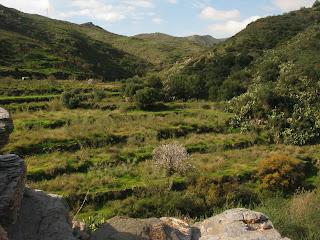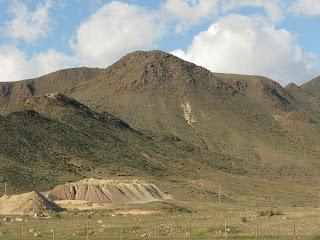-->
We are in Lanjaron and fancy a beer before going for a walk in the countryside around the town. This walk will be a mission because, although the nice young man in the oficina de turismo gave us a map and assured us that the route was easy to follow, we know that the waymarking will be erratic at best and completely non-existent for most of the time. A two hour walk will take three hours and will be punctuated by encounters with nasty dogs as we stray up private roads.
The walk starts opposite the Bar Manolete. The name rings a bell in the distant recesses of my brain, but I can't retrieve it from among the unrelated detritus there. The bar is un-prepossessing, glass and metal on a narrow frontage, and the sun prevents us from seeing what's happening inside. It is probably a place for locals, though – the tourist part of town is up the street where the hotels are. So we decide to try it.
There is always a bit of uncertainty about walking into a non-touristy bar in Spain. You are never quite sure of the reception. In our experience the person behind the bar is usually friendly, if a bit uncertain how to handle you – are you German, English or American? No doubt we all have our peculiarities. As long as you can order drinks competently in Spanish, and don't wally about, things usually go OK. A smile, a confident “hola” and strong eye contact can work wonders. After all, to the bar owner you are business. The regular clientele, however, are a different matter. You can be a source of intrigue in a locals bar, especially if you are a woman, eliciting sly looks from time to time from the regulars. It's usually just curiosity, although you get the occasional grumpy type who just doesn't want to smile when smiled at.
Bar etiquette can be a bit of a minefield – should you walk in and say “hola” to everyone you pass on the way to the bar? If you do, you can often see the mystification, bordering on panic, in their eyes as they try to come to terms with the situation. Better to smile and nod in greeting unless they say “hola” first. Be confident, but whatever you do, do not walk into the bar as if you own the place, especially if you're German. Enough said.
Well, the Bar Manolete is quite ordinary inside; the bar is down the left hand side, tables and chairs down the other, toilets at the back, muted decor. The one difference is that the bar is named after Manolete, from Cordoba, the most famous matador in Spain, who was killed in the bullring in 1947. On the walls are several framed newspaper pages marking the 40th anniversary of his death. In the photographs Manolete appears sombre and rather lugubrious, mainly due to his sad eyes and large pendulous nose. He reminds you of a Spike Milligan drawing of Eccles from the Goon Show.
The place is busy. It is about 1 o'clock. Sitting at the bar on high stools are a woman in business clothes, reading a newspaper and drinking coffee, two men from a utility company in their LEGO men work uniform, and a couple of other business types, including someone who could be a local politician who receives calls on his mobile 'phone and parades around outside the bar gesturing animatedly. The rest of the customers are old boys, some of whom are in clothes that have seen better days, usually a cardigan, shiny trousers and a flat cap. They stand at the bar, smoking and chatting, or wander around smoking and looking a bit lost.
The barman has his back to the bar and you wait a full minute taking it all in, then he turns and you are momentarily taken aback – he must surely be a close relation of Manolete himself because he has the same facial characteristics. He is thick-set, however, where Manolete was slender. He seems friendly and takes your order with a nod. You contemplate making a comment about Manolete - “Este Manolete, que stupendo torrero!” delivered with all the enthusiasm of Hemingway, but the linguistic quagmire this is likely to land you in, and the strong likelihood that you will sound like a presumptuous prat make you think better of it.
You take your beers. So far so good. You sit down at a table near the door and watch the customers at the bar dropping everything they can on the floor – serviettes, cigarette ends, old lottery tickets, the lot. One of the old boys clearly shouldn't be out alone. The cigarette between his lips has two inches of ash on it which cascades onto his cardigan and slippers as you watch, He shuffles to the door and on the inside of one trouser leg is a neatly burned hole. He is a walking future tragic news item. The patron casts a sympathetic, watchful eye over him as he leaves the bar, then catches your eye with a sad look that says he has seen a lot in his time. At least you have a shared understanding of something.
The beers arrive and then five minutes later the patron arrives with a plate. You had forgotten about the tapa that accompanies alcohol at lunch time and in the early evening. The tapas custom can be a minefield for the unknowing overseas traveller. You can never be sure whether or not you will get a tapa and if you do, whether it will be something you want to eat. Mostly they are OK and occasionally they are delicious. The tapa in this instance is clearly some sort of meat and chick pea stew. It is a yellow colour and has in it strips of something that looks like rubber bath mat. This stuff has pointy lumps all over it. You look at it in dismay and another tattered memory wafts into your consciousness of an illustration in a school biology book of the alimentary tract of a cow. Then the memory springs to life with a terrifying clarity. My god, it's tripe. This awful reality sinks in as you watch your wife hoovering up the chick peas on the plate. She is vegetarian and a chick pea afficionado, so will happily ignore the fact they are swimming in an oily, meaty sauce.
You didn't ask for a tapa, but you feel obliged, as an Englishman, a gentleman and a man of the world, to at least attempt to eat the stuff. It smells OK, but it's still tripe. Mother gave you some once and you never forgave her.
After a few attempts you get the fork to penetrate the rubbery surface and you pop the smallest piece you can find into your mouth in as nonchalant a manner as you can muster, aware of casual looks from the customers. Maybe this is some kind of joke played on foreigners. They get tripe, the Spanish get yummy meatballs in tomato sauce and they all have a good laugh about your reaction afterwards. But no, others in the bar are tucking into plates of it with relish. You chew and try to disconnect your brain from your taste buds by occupying it with thoughts of naked women or beautiful sunsets – anything. It's no good, you have to swallow it straight away, and it goes down your gullet like, well, a rubber bath mat might. Surreptitiously, you try to hide the remaining bits on your plate under the serviette and the fork.
You order another beer to help erase the memory of the tripe and down it in seconds, then go to the bar and ask for the bill, only to find the barman is offering you another plate of tapa this time two slices of bread with strips of dry, hard cured bacon on top, which you know from experience you will be chewing for the next two hours. This is a crisis. Customers either side of you are waiting to see how you handle this. You consult your watch, sorry that you are in a hurry and devastated to have to refuse such a tasty morsel, you shrug and gesture to indicate he might like to give it to one of the old boys. He does, reluctantly, and the recipient looks at you as if you've just asked him if he is incontinent. He doesn't want charity and ignores it.
The thing is, you don't have to eat the tapas you are given – we saw two businessmen in Granada receive three plates of appetising-looking tapas and leave the lot untouched without any embarrassment. But somehow this goes against the usual norms of English polite behaviour.
You muster as much dignity as you can, put on a fixed smile and make your exit. The street outside is bright, the beer is working and you have survived another close encounter with the real Spain.


































































